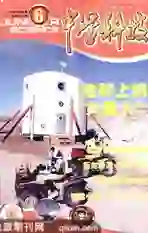Diamonds Glow
2008-07-02
Diamonds are expensive because they're beautiful and rare. But fake diamonds often sell for a lot of money, too, becausetheycan look very real. Now, scientists have discovered a way to distinguish certain genuine diamondsfromimitations. Thesimple new technique works with a rare form of blue diamond that glows in the dark.
Diamonds thatbelong toa group calledtypeIIb usuallylookblue. Aftertheyabsorbhigh-energy light, though, type IIb diamonds phosphoresce, or glow in the dark, for a little while. This phosphorescence ranges in color from blue to pink to fiery red, depending on the diamond.
Type IIb diamonds can be stunning, and some of them are quite famous. The large Hope Diamond, for one, glows orange-redforup toa minute afterthe lights go out.
Despite these diamonds' rarity and fame, however, scientistshadn'tpaidmuchattention tothemtill recently. To learn more about the stones, an American chemical engineer and her colleagues studied a set of diamonds called the Aurora Heart Collection. The set contains 239 colored diamonds, including many blue, type IIb gems.
They also studied the Smithsonian's Hope Diamond andits Blue Heart Diamond. In all, the researchers did experiments with 67 natural blue diamonds, three man-made gems, and a gray diamond that scientists had turned blue with a combination of temperature and pressure treatments.
In one test, the scientists shone ultraviolet light - a type of high-energy light - on each gemstone for 20 seconds. Afterward, all the natural type IIb diamonds glowed for several seconds.
Measurements revealed that this glow contained two wavelengthsofvisiblelight: greenish-blueand reddish. Therelativestrengthofeachwavelength determined thecolor of thefinal glow. Andbecause each diamond is different, the scientists could use the color of the glow and how quickly the glow fades as a sort of fingerprint to identify individual gems.
Thetechniquealso proved to be a good way to separate the real gems from the fakes. Neither the man-madediamondsnorthefalselycoloredgray diamond glowed in the reddish wavelength. The new strategy might help solve one of the diamond market's biggest problems: hard-to-spot fakes.
1. Thispassagemainlyintroduces _____.
A. the Smithsonian'sHope Diamond
B. the famous diamondsinthe world
C. a technique to produce man-made diamonds
D. a techniqueto identifyreal diamonds
2. It canbe learnedfromthe passage that the color of a diamond _____.
A. is imparted bynatureand never change
B. can bealteredwithartificial treatment
C. continually changes with temperature and pressure
D. darkenswheneverultraviolet light shines on it
3. According to the passage,which of the following statements is true?
A. Each diamond has its unique color and duration of the glow.
B. A specificsignisprovided toeachdiamondasasort of fingerprint.
C. It is thewavelengths of visible light that determine the value of diamonds.
D. Man-madediamonds usuallyglow inthe reddish wavelength.
Making Recycled Paper
You will need: 250mL beaker,scissors,whisk or blender, stirring rod, sieve, wide-mouthed container, deckle and mould, or rigid wire mesh square (approximately 20cm × 20cm) and egg ring,newspaper, firm cardboard or wood.
Making the pulp:
1. Cut or tear the selected paper type into pieces about 2 cm square. Cut upenoughtofilla 250mL container one-third full.
2. Addenoughwarmwaterto cover the paper. The paper should absorb the water and break down into a soggy pulp of fibres.
3. Use awhisk orablender to separate and evenly distribute all the fibres throughout the mixture. At this stage, chemicals and additivessuchasbleach, dyeand starch could be added to the pulp to change the quality of the paper.
4. If necessary, add more water to create a mixture about the consistency of cream.
Forming the paper:
A mouldand decklemaybe used to form the paper. The mould is a wooden frame that has mesh (fly screening) attached to it. The deckle is a wooden frame that should fit exactly into the mould. The size and shape of the piece of paper formed will be the same as theinsidearea ofthedeckle. Alternatively, an egg ring can be usedas thedeckle. Thiscan be placed over a piece of rigid wire mesh which is a substitute for the mould (see diagram).
5. Stirthemixtureuntilthe fibres are evenly distributed through the water. Place the deckle inside themouldover awide-mouthed container or hold themouldover thesink. Pourthe fibre mixture into the deckle and mould.
6. Usethebackofaspoonto squeeze the excess water out of the 'paper'. Remove the mould. Tip the 'paper' onto a piece of absorbent cloth or newspaper. Place more absorbent materials on top. Put a piece of firm cardboard or wood on top of all this and press firmly to remove more of the moisture from the 'paper'.
7. Uncoverthemoist'paper' and put it on some newspaper to dry.
上期Crossword答案
A. powerfulB. second
C. housedD. ceremony
E. research 1. change
2. forword3. projects
